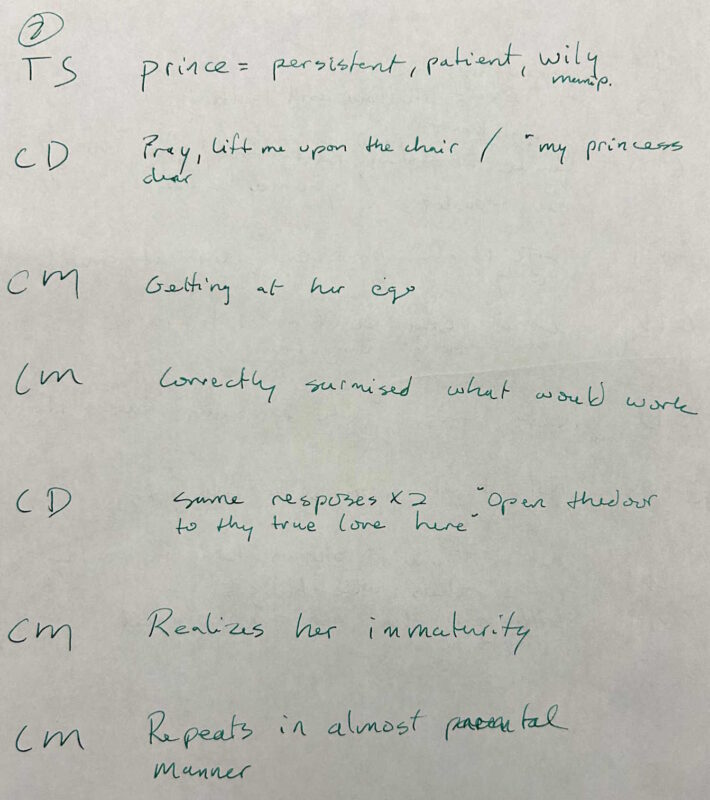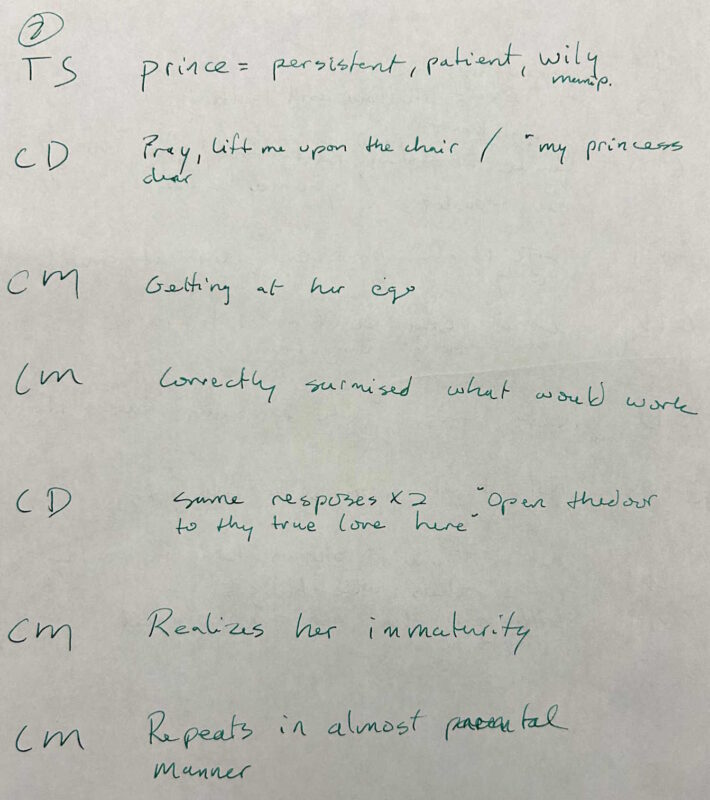Prewriting: The Graphic Organizers
As you look at the graphic organizers I created, notice that I never really write a complete sentence. I just write enough to help me remember what my original thoughts were. Writing the whole thing in the GO is not necessary, and it’s not always a good idea, either: You expend to much energy writing it out and might start cutting corners when you’re putting it into Mastery Connect.
Princess
My first thoughts were about the princess. Her personality was the clearest as I read, and I jotted down some quotes almost immediately. They were all listed under the CD together, though I knew I would eventually separate them. Once I’d read through it a couple of times, I looked at the quotes and figured out a way to group them. I then crossed out the ones I was going to use for CD2 so that they didn’t clutter my thinking once I started focusing on the commentary.

The Prince
The prince was much more challenging than the princess. I had to reread the story a couple of times to find something I liked. I was tempted to go all positive with him, and I did lean heavily toward a more positive interpretation, but there is an underlying sense that he is manipulative. I hinted that that a little, but I couldn’t really find clear quotes that I could use. I’m sure with more time and additional reading, I would find the, but given the time I had, I settled.

Version 1: Mr. Scott Writing as an English Teacher
This version is 464 words long. It uses some more complicated sentence structures, and it often uses three commentary sentences per chunk. Additionally, it slightly bends some of the rules we’ve implemented for Schaffer paragraphs, including at least one quote in commentary and mixing a bit of claim with evidence in some of the concrete details.
Authors have at their disposal only one tool: words. The word choices they make when writing, then, are of supreme significance, and a good author selects words for the specific impact they will have on the reader. The Brothers Grimm used word choice in “The Frog Prince” to demonstrate contrast the shallow, selfish immaturity of the princess with the prince’s wily and patient persistence.
The authors clearly show the princess’s shallow selfishness through their commentary on the princess’s actions and thoughts. For example, they make it clear that she is most interested in her “favorite plaything” and cannot “be troubled” with anything other than joy. Life is about entertainment for the princess, and her own fun is all she seeks. She can’t even be troubled with the fact that she’s interacting with a speaking frog. Such thoughts are too difficult for her, so she simply pushes them out of her mind. In addition, as she leaves behind the “nasty frog,” the authors show she has “quite forgotten” about the frog and “never thought” about it again. This is remarkable insofar as she was not impressed by the fact that an animal was carrying on a conversation with her. It wasn’t fun for her, so she didn’t remember it. The author’s use of “quite” shows how flippantly she takes the whole thing. The princess’s selfish shallowness is clear from the authors’ descriptions and commentary on her behavior.
The prince, on the other hand, is shown to be wily and persistent, exhibiting the patience of someone who is a master manipulator. For example, the authors have the frog phrase his interactions in very flattering and subservient ways, asking the princess, “Pray, lift me upon the chair” and constantly referring to her as “my princess dear.” The frog, seeing how obsessed the princess is with her “favorite plaything,” realizes the best way to get at the princess is through her ego. He understands that she thinks of herself first, and he frames all his interactions with her in that light. Additionally, the authors show how patient the frog is by having him repeat the exact same thing every time he interacts with the princess: “Open the door to they true love dear.” This repetition suggests an almost parental approach the frog is taking. It’s as if he is interacting with an incorrigible toddler, and like any patient parent, he simply and persistently repeats himself instead of engaging in an argument. Thus, the authors use the frog’s dialogue to show his wily patience.
Just as the prince is wily in his word choice with the princess, the Brothers Grimm cleverly used word selection to contrast the characters in “The Frog Prince.” They effectively show the prince to be wily and manipulative and the princess to be selfishly shallow.
Version 2: Simple Eighth-Grade Version
This version is 209 words long and makes use of very simple sentence structures. Everything is short and to the point. There is only a single sentence for the introduction and a single sentence for the conclusion.
The Brothers Grimm use word choice in “The Frog Prince” to show the princess is selfish and shallow and the prince is clever and persistent.
The princess is very selfish and shallow. For example, all she is interested in is her “favorite plaything.” This shows that for her, entertainment is the most important thing in life. She is more concerned about being happy than anything else. In addition, she quickly forgets about the “nasty frog.” This suggests that she’s not even curious about the fact that an animal is talking to her. Most people would find this fascinating, but she only finds it annoying. The authors show the princess to be selfishly shallow.
The prince is shown to be clever and persistent. For example, he keeps calling her “my princess dear.” This shows that he understands how selfish the princess is. He is using her selfishness to manipulate her. In addition, he continually says “Open the door to thy true love.” This suggests he recognizes her childishness. He’s repeating this like a patient parent would repeat something to a child. Cleverness and persistence are clearly the most obvious traits for the prince.
Word choice in “The Frog Prince” is critical to show the selfish princess and the clever prince.
0 Comments